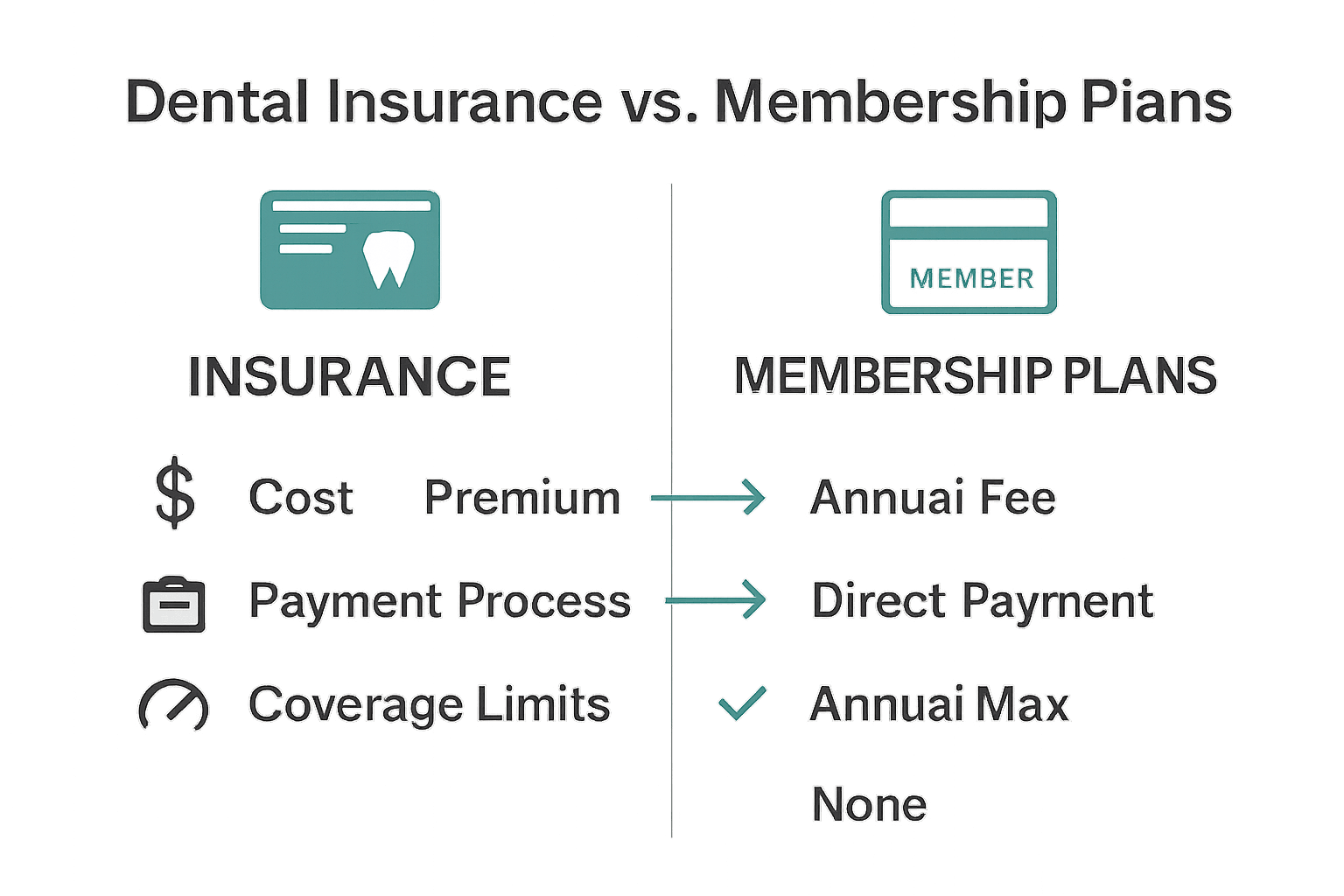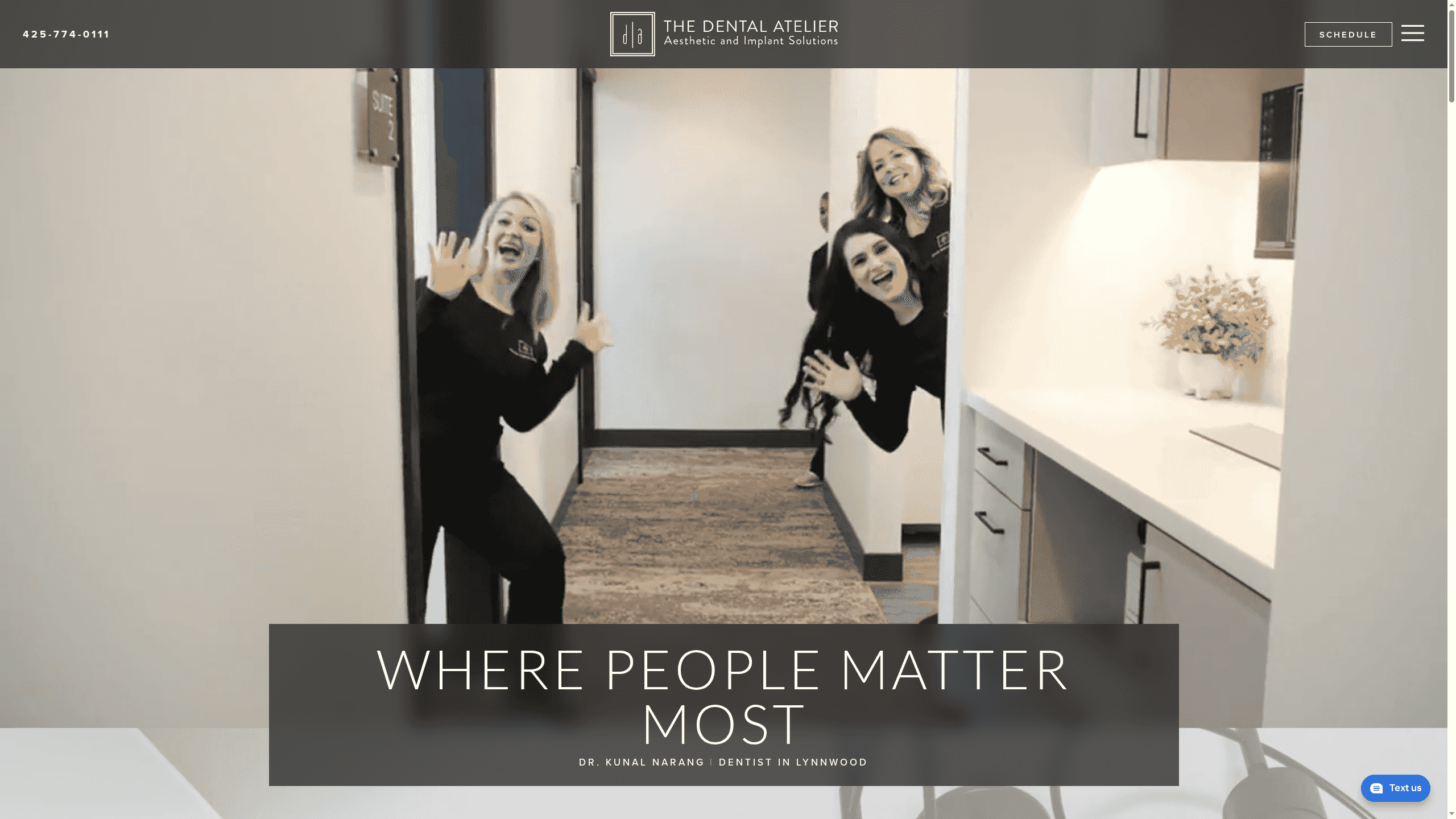The choice between dental insurance and membership plans can shape how much you spend and how easily you access care. More than 77 million adults in the US have little or no dental coverage, which drives many to seek practical alternatives. Knowing the differences between traditional insurance and membership plans helps you manage costs, avoid surprise bills, and choose the plan that fits your needs best.
Table of Contents
- What Dental Insurance And Membership Mean
- Types And Structure Of Each Option
- How Each Option Works In Practice
- Cost, Coverage And Limitations Compared
- Which Option Fits Different Patients
Key Takeaways
| Point | Details |
|---|---|
| Understanding Options | Dental insurance offers varying coverage percentages for services, while membership plans provide fixed discounts in exchange for an annual fee. |
| Cost Structure Differences | Insurance typically involves monthly premiums and copays, while membership plans operate with a single payment and no complex claims. |
| Best Fit for Patients | Insurance suits those needing extensive treatments or comprehensive workplace benefits, whereas membership plans benefit self-employed individuals and those without insurance. |
| Transparent Pricing Advantage | Membership plans eliminate third-party insurers, providing clearer costs and smoother access to dental care. |
What Dental Insurance And Membership Mean
Dental insurance and membership plans are two distinct approaches to managing dental healthcare costs, each offering unique benefits and structures for patients seeking affordable dental care. According to Britannica, dental insurance typically covers a range of services from preventive care to basic and major procedures, with varying levels of coverage percentages and annual maximums.
In contrast, Aflac explains that dental membership plans operate differently from traditional insurance. These plans provide access to reduced dental service rates through participating dentists in exchange for a membership fee. Unlike insurance, membership plans do not provide direct coverage but instead offer discounted services at predetermined rates.
The key differences between dental insurance and membership plans include:
- Coverage Scope: Insurance often covers a percentage of procedural costs, while memberships offer fixed discounts
- Cost Structure: Insurance requires monthly premiums and potential copays, whereas memberships involve a single annual fee
- Service Network: Both typically require using in-network providers for maximum financial benefits
For patients in Lynnwood and surrounding areas seeking comprehensive dental care, understanding these options can help make more informed healthcare decisions. Dental membership plans at our practice offer an affordable alternative for those without traditional insurance, providing transparent pricing and predictable healthcare costs.
Types And Structure Of Each Option
According to Britannica, dental insurance plans come in several distinct structures, each offering unique benefits and limitations. The primary types include Dental HMOs, Dental PPOs, Dental Indemnity Plans, and Discounted Dental/Dental Savings Plans, which provide patients with varying levels of flexibility and coverage options.
Dental HMOs (Health Maintenance Organizations) typically require patients to select a primary dentist within a specific network and obtain referrals for specialized treatments. These plans often feature lower monthly premiums but more restricted provider choices. Dental PPOs (Preferred Provider Organizations), in contrast, offer greater flexibility by allowing patients to see both in-network and out-of-network dentists, though in-network providers result in lower out-of-pocket expenses.
Dental Membership Plans, as Aflac explains, operate differently by providing discounted rates through a network of participating dentists. These plans involve paying a membership fee that grants access to predetermined reduced pricing on various dental services.
Key characteristics of each option include:
-
Dental HMOs
- Lowest monthly premiums
- Strict network requirements
- Requires primary dentist selection
-
Dental PPOs
- More provider flexibility
- Higher monthly premiums
- Partial coverage for out-of-network providers
-
Dental Membership Plans
- Fixed annual membership fee
- Immediate discount access
- No complex claims process
For patients in Lynnwood seeking comprehensive dental care, understanding these structural differences can help make more informed healthcare decisions.
IMAGE:descriptive_key_1] [Learn more about our membership options for personalized dental care solutions.
How Each Option Works In Practice
Dental membership plans offer a streamlined approach to dental care that differs significantly from traditional insurance models. According to Dental Economics, these plans eliminate third-party insurers, providing patients with transparent pricing and better access to care. The average cost hovers around $33.04 per month in nonrural areas, making them an attractive alternative for many patients.
Aflac explains that dental discount plans operate by requiring a membership fee that grants access to a network of dentists offering reduced-rate services. In this model, patients pay the full discounted cost out of pocket, which differs from traditional insurance where a portion of the cost is typically covered by the insurance provider.
Practical workflow for each option typically follows these patterns:
Dental Insurance Process:
- Pay monthly premium
- Schedule dental appointment
- Receive treatment
- Dentist submits claim to insurance
- Insurance processes claim
- Patient receives billing for remaining balance
Dental Membership Plan Process:
- Pay annual membership fee
- Receive immediate discount access
- Schedule appointment
- Pay reduced rate directly to provider
- No complex claim submissions
For patients in Lynnwood seeking predictable and transparent dental care costs, understanding these practical differences can help make more informed healthcare decisions. Explore our membership options for a simplified approach to dental care that puts you in control.
Cost, Coverage And Limitations Compared
According to Britannica, traditional dental insurance provides tiered coverage with distinct reimbursement levels: preventive care is typically covered at 100%, basic procedures around 80%, and major procedures at approximately 50%. Most plans also include an annual maximum benefit of $1,500, which can significantly impact comprehensive treatment planning.
Aflac highlights that dental discount plans operate differently, offering lower membership fees but requiring patients to pay the full discounted cost out of pocket. This approach provides immediate cost savings without the complex claims process associated with traditional insurance.
A comprehensive comparison of cost structures reveals key differences:

Dental Insurance Limitations:
- Annual maximum benefit caps
- Waiting periods for major procedures
- Complex claims submission process
- Higher monthly premiums
- Partial coverage for advanced treatments
Dental Membership Plan Advantages:
- Transparent, upfront pricing
- No annual benefit maximums
- Immediate discount access
- Lower overall costs
- Simplified payment process
For patients in Lynnwood seeking clarity on dental care expenses, understanding these nuanced differences is crucial. Explore our detailed dental insurance terms guide to make an informed decision about your dental healthcare investment.
Which Option Fits Different Patients
Dental Economics reveals that dental membership plans can significantly benefit patients without traditional insurance by eliminating financial barriers and promoting proactive health management. These plans are particularly advantageous for individuals seeking transparent, predictable dental care costs without complex insurance bureaucracy.
Aflac suggests that dental discount plans are ideal for patients who anticipate needing various dental procedures and prefer paying reduced rates directly to providers. Understanding individual healthcare needs is crucial in selecting the most appropriate dental coverage strategy.
Patient profiles that might prefer each option include:
Dental Insurance Best For:
- Employees with comprehensive workplace benefits
- Patients requiring extensive, complex treatments
- Individuals with predictable annual healthcare spending
- Those needing coverage for major dental procedures
- Patients with chronic dental health conditions
Dental Membership Plans Ideal For:
- Self-employed professionals
- Freelancers and independent contractors
- Students and young adults
- Patients without employer-sponsored dental coverage
- Individuals seeking preventive and routine care
For Lynnwood residents exploring dental care options, matching your specific healthcare needs and financial circumstances to the right plan is essential. Learn more about our membership options to find the perfect fit for your dental health journey.
Make Smart Choices with Dental Insurance and Membership Plans
Understanding the difference between dental insurance and membership plans can be overwhelming when you want affordable and transparent dental care. This article highlights how each option affects costs, coverage, and your ability to access care without surprises. If you have struggled with confusing insurance claims, unexpected bills, or limited dental networks, you are not alone. Many patients seek clarity, predictable pricing, and simple solutions that fit their unique needs.
At Dental Ateliers, we specialize in providing flexible options including dental membership plans designed to eliminate complicated claims and deliver immediate discounts. Our patient-centered approach prioritizes comfort, clear pricing, and personalized care while offering access to advanced treatments like implants, same-day crowns, and Invisalign.

Are you ready to take control of your dental health with options that work for your budget and lifestyle? Visit Dental Ateliers to explore our membership plans, learn about our wide range of treatments, and schedule a consultation. Don’t wait until anxiety over dental costs stops you from getting the care you deserve. Discover a transparent, welcoming experience by checking out our membership plans and reading patient success stories today.
Frequently Asked Questions
What is the difference between dental insurance and dental membership plans?
Dental insurance typically covers a percentage of procedural costs and involves monthly premiums and annual maximums, while dental membership plans offer fixed discounts on services in exchange for an annual membership fee with no complex claims process.
How do dental membership plans work?
Dental membership plans require payment of an annual fee that grants members access to discounted rates for dental services at participating providers, eliminating the complexity of insurance claims.
What are the limitations of traditional dental insurance?
Traditional dental insurance may have annual maximum benefit caps, waiting periods for major procedures, and higher monthly premiums, which can impact your overall dental care costs and accessibility.
Which option is better for patients without insurance: dental membership plans or traditional insurance?
Dental membership plans are often better for patients without insurance as they offer transparency, lower costs, and immediate access to discounts, making dental care more manageable without extensive bureaucracy.
Recommended
- Dental Insurance Terms Explained: Complete Guide | The Dental Atelier
- 7 Types of Dental Insurance Alternatives for Affordable Care | The Dental Atelier
- How to Find Uninsured Dental Options Step by Step | The Dental Atelier
- Maximize Your Dental Benefits Before Year-End | Dental Ateli | The Dental Atelier


.svg)